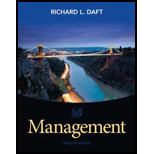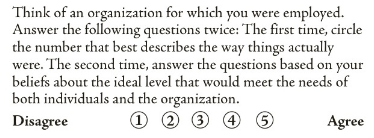
Management
12th Edition
ISBN: 9781305393462
Author: DAFT, Richard L.
Publisher: South-Western College Pub
expand_more
expand_more
format_list_bulleted
Concept explainers
Question
Chapter 5, Problem 7EE
Summary Introduction


To determine:
To think of an organization for which I was employed.
Introduction:
An organization refers to the business or government department where an organized group of people are working with a particular purpose.
Expert Solution & Answer
Want to see the full answer?
Check out a sample textbook solution
Students have asked these similar questions
give brief peer-reviewed example of a single-supplier and multiple supplier sourcing strategy from within 2019-2024
Referencing the scenario provided, and following the guidance provided by theStrategic consultant, Joy and her team are now prepared to proceed with finalizing their businessplan to launch their company. Considering how competitive the business sector is today, it isimportant that they are aware of their alternative organizational strategies. It is also important thatthey understand how to develop a sustainable competitive advantage, so as to remain financiallyviable. The group is considering utilizing the strategy formulation framework to aid in developingthe company and its products. Further to discussion with the Strategic Consultant, Joy is awarethat there are certain habits that strategic leaders must encompass but is not sure what they are. your group is to assume the role ofJ oy and her team. In doing so, you areexpected to complete the following:
Given the event planning and gifts for all occassions which your business proposes to offer, assess the threestages of the…
Relever les défis de la gestion des ressources humaines, 6e édition (Chapitre 7, page 256)
Auteur(s) Sylvie St-Onge, Victor Haines, Sylvie Guerrero, Julie Dextras-Gauthier
Chapter 5 Solutions
Management
Ch. 5 - Prob. 1OTJVCCh. 5 - Prob. 2OTJVCCh. 5 - Prob. 3OTJVCCh. 5 - Prob. 1DQCh. 5 - Prob. 2DQCh. 5 - Prob. 3DQCh. 5 - Prob. 4DQCh. 5 - Prob. 5DQCh. 5 - Prob. 6DQCh. 5 - Prob. 7DQ
Ch. 5 - Prob. 8DQCh. 5 - Prob. 9DQCh. 5 - Prob. 10DQCh. 5 - Prob. 1EECh. 5 - Prob. 2EECh. 5 - Prob. 3EECh. 5 - Prob. 4EECh. 5 - Prob. 5EECh. 5 - Prob. 6EECh. 5 - Prob. 7EECh. 5 - Prob. 8EECh. 5 - Prob. 9EECh. 5 - Prob. 10EECh. 5 - Prob. 1SGBCh. 5 - Prob. 1EDCh. 5 - Prob. 2EDCh. 5 - Prob. 3EDCh. 5 - Prob. 1CFCACh. 5 - Prob. 2CFCACh. 5 - Prob. 3CFCA
Knowledge Booster
Learn more about
Need a deep-dive on the concept behind this application? Look no further. Learn more about this topic, management and related others by exploring similar questions and additional content below.Similar questions
- This question is regarding business negotiation BUS356 in SUSS. The case below is extracted from Harvard Business Review Case Study “Move Fast,but without Bias: Ethical AI Development in a Start-up Culture”. It is important to support your answers with specific examples based on thescenario given in the case study below to demonstrate your understanding andapplication of the relevant concepts. You may make reasonable assumptions, aspart of your analysis. Answers must be supported with theoretical models and concepts from therecommended textbook, Lewicki, R. J., Saunders, D. M. & Barry, B. (2021). Essentialsof Negotiation (7th ed). New York: McGraw-Hill International Edition and coursematerials. Please provide useful links and citations for learning purposes.arrow_forwardThis question is regarding business negotiation BUS356 in SUSS. The case below is extracted from Harvard Business Review Case Study “Move Fast,but without Bias: Ethical AI Development in a Start-up Culture”. It is important to support your answers with specific examples based on thescenario given in the case study below to demonstrate your understanding andapplication of the relevant concepts. You may make reasonable assumptions, aspart of your analysis. Answers must be supported with theoretical models and concepts from therecommended textbook, Lewicki, R. J., Saunders, D. M. & Barry, B. (2021). Essentialsof Negotiation (7th ed). New York: McGraw-Hill International Edition and coursematerials. Please provide useful links and citations for learning purposes. One of the attached documents is the question while another one is some tips of negotiationarrow_forwardIdentify potential ethical challenges in producing and marketing your company's skincareproducts from jamaica in europe and associated countries like germany italy and france and how your team will address them.arrow_forward
- Make a total of 19-20 slides below the topic and give some briefs, which I should say as a speech for presentation time with that slide. (a) title slide(b) the content of the presentation and the presenter (4presenter-for each 4-5 slide) for each section(c) Topic: Factor what is more important to Gen X,Y,Z in their receptivity to international assignments. Critically discuss how factors such as culture, personality, and skills/experience may impact generational differences. The presentation should discuss how managers can use human resource planning to attract a multigenerational workforce interested in international career assignments.it considers the internal and external labour supplyarrow_forwardThis question is regarding business negotiation BUS356 in SUSS. The case below is extracted from Harvard Business Review Case Study “Move Fast,but without Bias: Ethical AI Development in a Start-up Culture”. It is important to support your answers with specific examples based on thescenario given in the case study below to demonstrate your understanding andapplication of the relevant concepts. You may make reasonable assumptions, aspart of your analysis. Answers must be supported with theoretical models and concepts from therecommended textbook, Lewicki, R. J., Saunders, D. M. & Barry, B. (2021). Essentialsof Negotiation (7th ed). New York: McGraw-Hill International Edition and coursematerials. Please provide useful links and citations for learning purposes.arrow_forwardThis week we focused on how to manage corporate social responsibility (CSR) and sustainability efforts. Initial Post Instructions Identify one CSR activity that would align well with the organization and country you selected for your final project. Explain why you believe this CSR activity is a good fit for both the organization and the selected expansion country. Describe one outcome that you would like to achieve from this CSR activity. In your responses to two classmates’ discussion posts, provide a different CSR activity that you recommend for your classmates’ projects. Alternatively, you may provide feedback to your classmates’ selected CSR activity pointing out a possible risk to this action and why you think this CSR activity is risky.arrow_forward
- Develop a worthwhile, substantial, and innovative strategic initiative. Your strategic initiative could be for an organization for which you work, or have worked, or for an organization for which you would like to work. For MGT451’s purposes, an organization can be a formal organization such as a for-profit business or a not-for-profit agency. For example, if your ideal job is to be a marketing manager for a consumer products company, develop an initiative to launch a new hair care product into the US market. For this assignment profile the organization, your ideal role in the organization, the nature of the strategic initiative, goals to be achieved, and likely measures of success.arrow_forwardCSR and Corporate Ethics - A Global Approach This week you will start working on your Portfolio Project sections. This Critical Thinking assignment can contribute to the completion of the final portfolio project due in Module Eight. As you complete the module assignments, integrate any feedback from your instructor and the knowledge you gain from taking the course to update your assignments in preparation for completing your international expansion plan due in Module Eight. Now that you have identified the organization, country, and product, the Management Team has asked you to prepare a memo for them for the next meeting to include the research you have gathered on the following topics. Please address your memo to the Managing Director and use an appropriate heading for each of the topics listed. Country Background: Provide a brief overview of the country you have chosen and why you think it will be a good location for the organization to manufacture the proposed product. Corporate…arrow_forwardStrategy Formation Experiences Please share an experience in which you played the strategist. What was intended to be achieved? Did the guiding strategy form deliberately, did the guiding strategy emerge or did both elements–deliberate and emergent strategy come into play? Reflecting on your experience, how could the strategy formation process you used be improved?arrow_forward
- Discuss the importance of Ethical leadership from the perspective of King IV and Virtue Ethicsarrow_forwardGeneral accountingarrow_forwardThe St. Louis Cardinals would like to improve their post season performance this year. They have hired you as a consultant to study the team during winter practice and help their analytics team to fine tune their on-field performance. Armed with your recent knowledge of sampling and estimation, you set to collect data and provide feedback to the team. How can you help the team from what you have learned in this chapter? Describe your sampling plan? What data would you like to collect, the parameter(s) of interest. How you would use the confidence interval to inform the team?arrow_forward
arrow_back_ios
SEE MORE QUESTIONS
arrow_forward_ios
Recommended textbooks for you
 Management, Loose-Leaf VersionManagementISBN:9781305969308Author:Richard L. DaftPublisher:South-Western College Pub
Management, Loose-Leaf VersionManagementISBN:9781305969308Author:Richard L. DaftPublisher:South-Western College Pub Understanding Management (MindTap Course List)ManagementISBN:9781305502215Author:Richard L. Daft, Dorothy MarcicPublisher:Cengage Learning
Understanding Management (MindTap Course List)ManagementISBN:9781305502215Author:Richard L. Daft, Dorothy MarcicPublisher:Cengage Learning Foundations of Business - Standalone book (MindTa...MarketingISBN:9781285193946Author:William M. Pride, Robert J. Hughes, Jack R. KapoorPublisher:Cengage Learning
Foundations of Business - Standalone book (MindTa...MarketingISBN:9781285193946Author:William M. Pride, Robert J. Hughes, Jack R. KapoorPublisher:Cengage Learning Foundations of Business (MindTap Course List)MarketingISBN:9781337386920Author:William M. Pride, Robert J. Hughes, Jack R. KapoorPublisher:Cengage Learning
Foundations of Business (MindTap Course List)MarketingISBN:9781337386920Author:William M. Pride, Robert J. Hughes, Jack R. KapoorPublisher:Cengage Learning

Management, Loose-Leaf Version
Management
ISBN:9781305969308
Author:Richard L. Daft
Publisher:South-Western College Pub


Understanding Management (MindTap Course List)
Management
ISBN:9781305502215
Author:Richard L. Daft, Dorothy Marcic
Publisher:Cengage Learning

Foundations of Business - Standalone book (MindTa...
Marketing
ISBN:9781285193946
Author:William M. Pride, Robert J. Hughes, Jack R. Kapoor
Publisher:Cengage Learning

Foundations of Business (MindTap Course List)
Marketing
ISBN:9781337386920
Author:William M. Pride, Robert J. Hughes, Jack R. Kapoor
Publisher:Cengage Learning